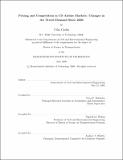Pricing and competition in US Airline markets : changes in air travel demand since 2000
Author(s)
Geslin, Célia
DownloadFull printable version (850.2Kb)
Alternative title
Pricing and competition in United States Airline markets : changes in air travel demand since 2000
Other Contributors
Massachusetts Institute of Technology. Dept. of Civil and Environmental Engineering.
Advisor
Peter P. Belobaba.
Terms of use
Metadata
Show full item recordAbstract
Since 2000, the US airline industry has been in turmoil. The economic downturn, September 11 and other factors all have had a negative impact on the spending behavior of consumers, and consequently airlines have posted tremendous revenue losses. The objective of this thesis is to analyze fare and passenger changes in the United States between 2000 and 2004 and to observe how air travel demand has changed recently. The Origin and Destination Survey of the US Department of Transportation is the main data source from which the Top 1000 Markets of 2004 were extracted and consistently matched back to 2000 in order to observe market changes. First, an aggregate statistical analysis was performed to conclude that average fares had decreased 16.4% by 2004, whereas traffic rebounded to 2000 levels after dropping by 11%. As a result, revenues had dropped 17.3% by 2004 compared with 2000. The total market sample was then segmented by distance, hub versus non-hub, low-fare airlines' market share, and overall market competition to determine the impact of each factor. These analyses resulted in the following findings. New entry of low-fare airlines resulted in the greatest decline of 31.3% in average fare by 2004. (cont.) Short-haul travel demand declined by 16% while fares remained stable; on the other hand, long-haul markets experienced a 29% decrease in fare which resulted in a 9% increase in traffic. The average fare of hub markets decreased by over 19% -- a greater decline than for non-hub markets. The average fare for low concentration markets experienced a decrease of 24% resulting in a passenger stimulation of 13%. Finally, regression analyses were performed to analyze the interactions between the different factors. These analyses further supported the previous findings and provided some new insights. The presence and growth of low-fare airlines in a market considerably decreases the average fare and increases the number of passengers. Hub premiums declined between 2000 and 2004, but are still evident for hub markets in which dominant carriers can exercise pricing power, and market concentration was shown to be positively correlated with slightly higher fares.
Description
Thesis (S.M.)--Massachusetts Institute of Technology, Dept. of Civil and Environmental Engineering, 2006. This electronic version was submitted by the student author. The certified thesis is available in the Institute Archives and Special Collections. Includes bibliographical references (p. 101-104).
Date issued
2006Department
Massachusetts Institute of Technology. Department of Civil and Environmental EngineeringPublisher
Massachusetts Institute of Technology
Keywords
Civil and Environmental Engineering.